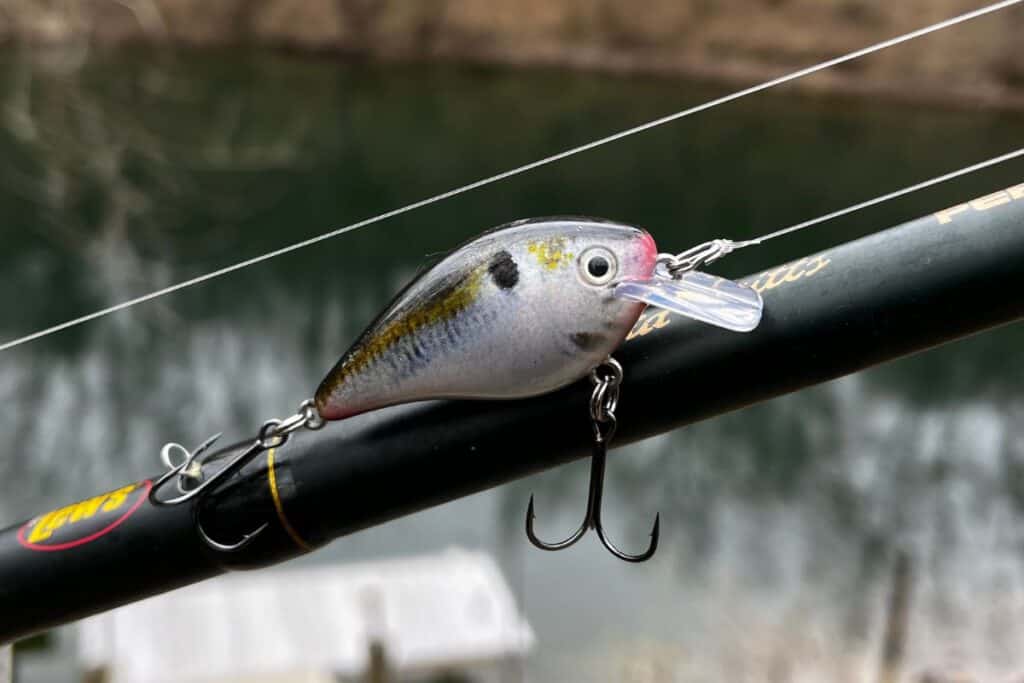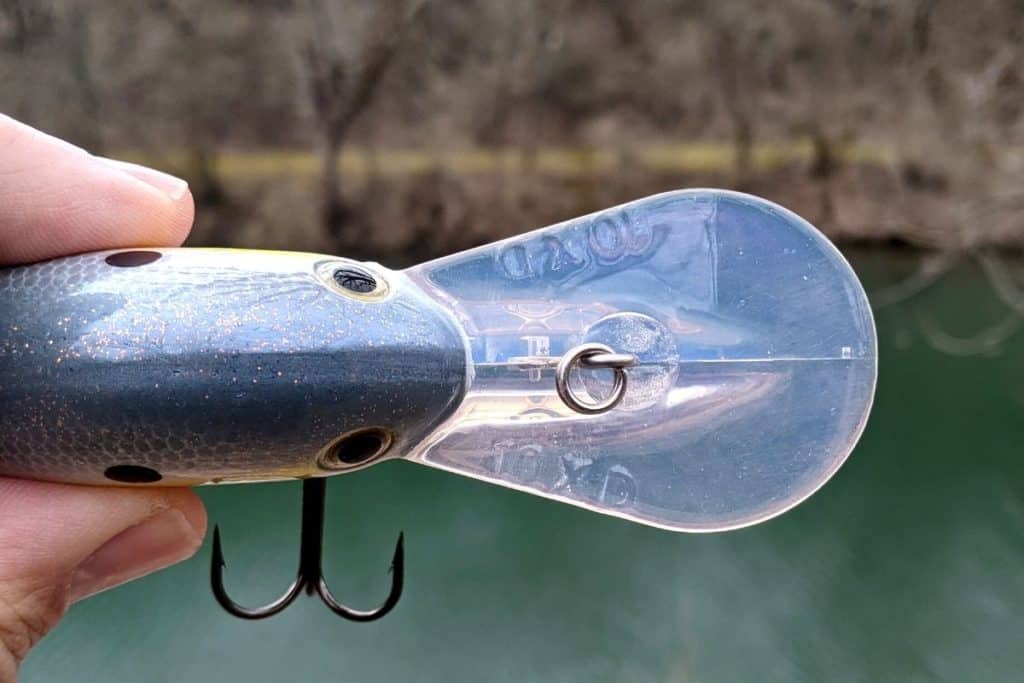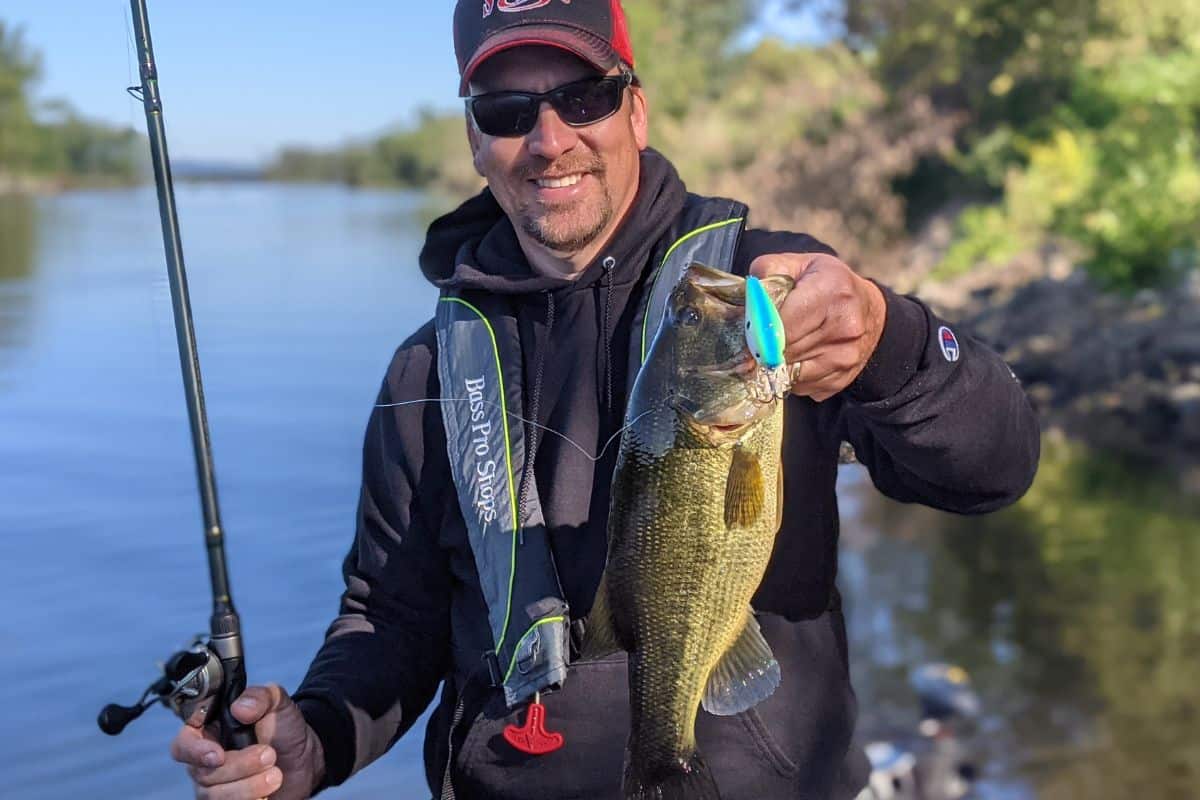Anglers looking to be successful with crankbaits need to use a rod designed specifically for this style of fishing.
A true crankbait rod is often made from a graphite and fiberglass composite that has a lot of parabolic action. Rod length will vary based on the style of crankbait being used.
This guide will break down how to choose the right rod for the right type of crankbait fishing you like to do.
Defining Power Rating and Action for Rod Selection
These two terms are often used interchangeably, but they have very different meanings.
To keep it simple, power rating refers to the stiffness of the rod. Action means the amount of flex in the tip and how fast the tip gets to the backbone, or power, of the rod.
The following terms and definitions are used by most rod manufacturers.
| Power Rating | Definition |
| UL | Ultra-light |
| L | Light |
| ML | Medium-light |
| M | Medium |
| MH | Medium-heavy |
| H | Heavy |
| XH | Extra-Heavy |
| Action Rating | Definition |
| M | Moderate |
| MF | Moderately-Fast |
| F | Fast |
| XF | Extra-Fast |
When lures are heavier or used in thick cover like vegetation and brush, anglers opt for medium-heavy, heavy, or extra-heavy power-rated rods. They need the winching power and leverage to keep bass from burying deeper into the thick stuff and pulling off.
For example, many die-hard hollow-body frog anglers like heavy or extra-heavy power-rated rods.

Lighter power ratings are used for finesse techniques like drop shots, Ned rigs, and vertical jigging something like a Damiki rig.
We need to take this same application method when thinking about power rating with different styles of crankbaits.
Action, or flex in the rod tip, makes a dramatic impact on not only setting the hook but also on casting accuracy. A rod with a moderate action will flex a lot and make precision casting more challenging than a rod with a fast action.
(Here is an article about proper hooksets when using crankbaits.)

What is a Crankbait Rod and Why it Matters
As mentioned at the beginning of this article, a rod designed for use with crankbaits is often a composite blend of both graphite and another material like fiberglass.
The result is a rod that is perfect for lures that use treble hooks.
This composite rod will not be quite as sensitive as a lightweight carbon fiber/graphite rod. That is a good thing when using crankbaits.
When a fish hits the lure, we just want to feel the weight and maintain pressure. If we use a rod that is extremely sensitive our natural instinct to set the hook would end up ripping the lure away from the fish.
Treble hooks behave much differently than a single-point model. The trebles “grab” bass more than they penetrate. It is because of this that applying too much pressure will tear the hooks free and leave anglers frustrated.
This is why almost every crankbait rod, no matter what the power rating, has a moderate action. This parabolic flex allows the bass to give and take while maintaining the right amount of pressure.
The below chart lists popular crankbait rod sizes and what types of lures they are best paired with. This data is from Lew’s KVD line of crankbait rods.
| Model # | Style | Crankbait Type | Length | Power | Action | Line |
| LKVDCC1 | Casting | Small Crankbaits | 6’8″ | ML | M | 8-12 |
| LKVDCC2 | Casting | Squarebill/Red Eye Shad | 7′ | M | M | 10-17 |
| LKVDCC3 | Casting | Accuracy Bladed Jig/KVD 2.5 | 7′ | MH | M | 12-20 |
| LKVDCC4 | Casting | Medium Crankbaits | 7’4″ | MH | M | 12-20 |
| LKVDCC5 | Casting | Open Water Bladed Jig/KVD 2.5 | 7’4″ | H | M | 12-30 |
| LKVDCC6 | Casting | Deep Divers | 7’10” | M | M | 10-17 |
Why Rod Length Matters With Crankbaits
Like everything in bass fishing, it seems there are so many choices that anglers can be overwhelmed. Crankbait rods can be the same way.
Longer rods, usually those that are 7’ 6” or greater, are best paired with larger, deep-diving crankbaits.
When fishing these big-lipped lures anglers need maximum distance. Big cranks are not used for pinpoint casting around docks and other visible targets. These lures are meant to get down to the bottom and dredge up schools of bass.

What most anglers do not realize, is that the time the lure is actually in the “zone” and doing what it should is minimal. The initial dive to depth and then the angled slope back to the boat take up a significant portion of the cast.
Savvy crankbait anglers throw the lure well past their intended target area. This helps ensure the lure is hitting the zone at the right time.
Long rods with good parabolic action allow for plenty of whip. A skilled crankbait angler can hurl these lures a tremendous distance, therefore, increasing the amount of time the bait is actually working for us.
Shorter rod lengths, 6’10” – 7’4”, are perfect for casting crankbaits with accuracy around visible targets. My favorite squarebill crankbait rod is 7’ in length. This lets me parallel a rocky shoreline and cast with ease. The shorter rod is also ideal for manipulating the tip. In other words, I can easily move the rod tip to steer and guide the squarebill into and around the cover.
Like the longer rods, it too has a moderate action and lots of flex.
(Here is an article about the ideal gear ratio for fishing crankbaits.)
What About Jerkbait Rods?
This is a question I am often asked about. I don’t categorize a jerkbait as a crankbait.
Its retrieve requires anglers to rip the lure on a slack line to get the most side-to-side action. In this case, too much parabolic action will not send enough energy to the lure.
My favorite hard jerkbait rod is 6’ 8” and has a medium-heavy power rating with a fast action. The shorter length is perfect for keeping the rod tip down towards the water’s surface.
Good luck out there and be sure to encourage someone today. You never know how you may change their life forever.
Isaiah 6:8

